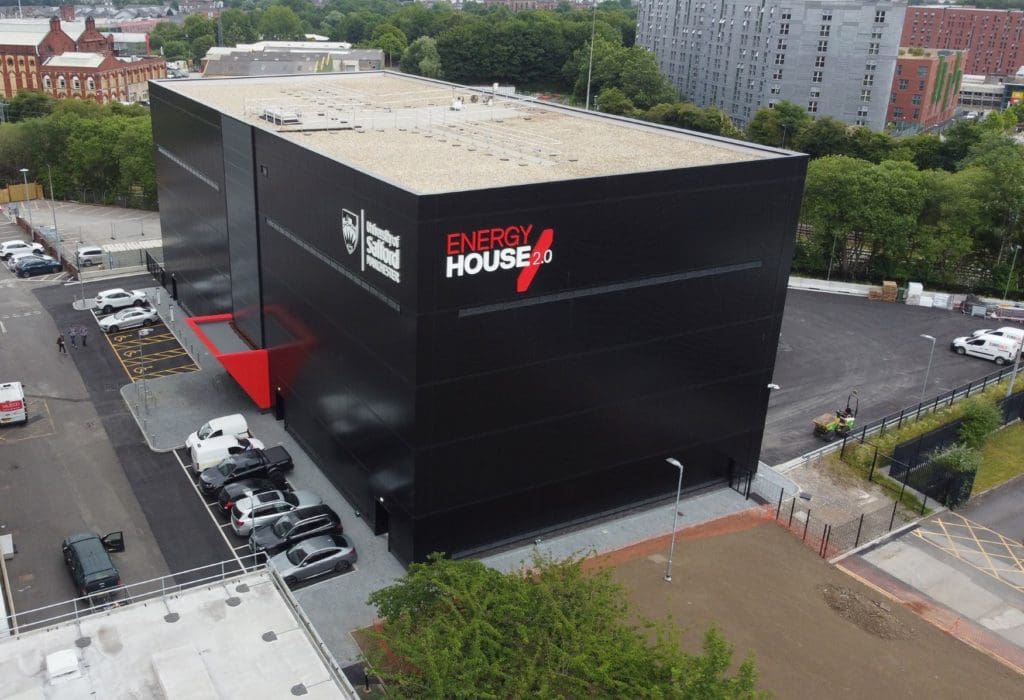
The heat pump will be tested in Bellway’s experimental eco house, The Future Home, at The University of Salford, where is has been installed. Bellway has engineered the house to support the 200kg air source heat pump within the roof space and a second unit will be fitted to an external wall to enable comparisons to be drawn.
Already installed in many new homes, air source heat pumps are usually fitted to, or adjacent to, an exterior wall which can dominate the external appearance and take up valuable outdoor space. With the current expectation that the pumps are expected to replace natural gas boilers in most homes as fossil fuel systems are phased out from 2025, the home will test low-carbon technologies and their impact on the cost of living.
A bold move
The Future Home is being built by Bellway inside a climate-controlled chamber at the university as part of its £16M Energy House 2.0 research project, which is being part-funded by the European Regional Development Fund.
Jamie Bursnell, group technical and innovations manager for Bellway, said: “Installing an air source heat pump within a loft space is a bold move – one that no UK developer or retrofit project has previously attempted.
“During the research period we will have people living within the home to test the performance of the heat pump during real-life use. If the unit in the loft performs well, it could create a new way for homeowners to reduce their carbon footprint without compromising on space or aesthetics.
“It is well documented that air source heat pumps could increase running costs but so far there is little reliable data on their performance. We are looking to find the optimum settings to maximise effectiveness and minimise cost for our customers.
“We will be able to compare the data from the two heat pumps to determine the most viable option for the future.”
Influencing low carbon decisions
The Future Home will also test underfloor and infrared heating, as well as a host of low-carbon innovations. These include mechanical ventilation, double versus triple glazing, battery storage for solar energy and a shower which transfers heat from wastewater to warm the incoming mains supply mains. This reduces the energy demand from the shower.

Jamie added: “The eyes of the new homes industry are focused firmly on this trial, but its impact could be much broader. The results could influence how householders make decisions as they replace their boilers in the coming years.”
Bellway has worked closely with home heating manufacturer Worcester Bosch to prepare for this ground-breaking trial, with the company providing the Bosch 3400i Hydrotop Solution unit. Donaldsons Timber Systems redesigned the home’s timber frame to accommodate the unit.
Viable alternative
Darran Burrage, UK New Build director at Worcester Bosch, said:“We are delighted to be part of this innovative trial. It is one of many that we at Worcester are involved in to help introduce low carbon heating technology into UK homes.
“One barrier for existing properties to convert to a heat pump is size and location. By placing an air source heat pump in the loft of The Future Home, the trial will hopefully pave the way for an alternative location and if successful enable more homeowners to see the technology as a viable greener heating alternative in the future.”
Professor Will Swan, director of Energy House Labs at the University of Salford, said: “The growing challenges of climate change and the cost-of-living crisis mean we need to consider how we build and operate our homes. Energy House Labs’ mission is to work with industry and policy makers to provide evidence for what works in meeting these challenges.
“Energy-efficient, high-performing homes can change people’s lives. The importance of this agenda is one of the main reasons behind the University of Salford’s major investment in Energy House 2.0, which is a critical piece of research infrastructure that can help us find solutions to these problems.”
Bellway’s Future Home at The University of Salford is in its final stages of build. Once complete it will be dressed by interior designers, so it is ready to be occupied.
In the new year, guests will be invited to stay in the home so data can be collected on the effectiveness of each innovation. Experts at the university will analyse the results to help determine the most viable ways for the industry to move towards net zero.